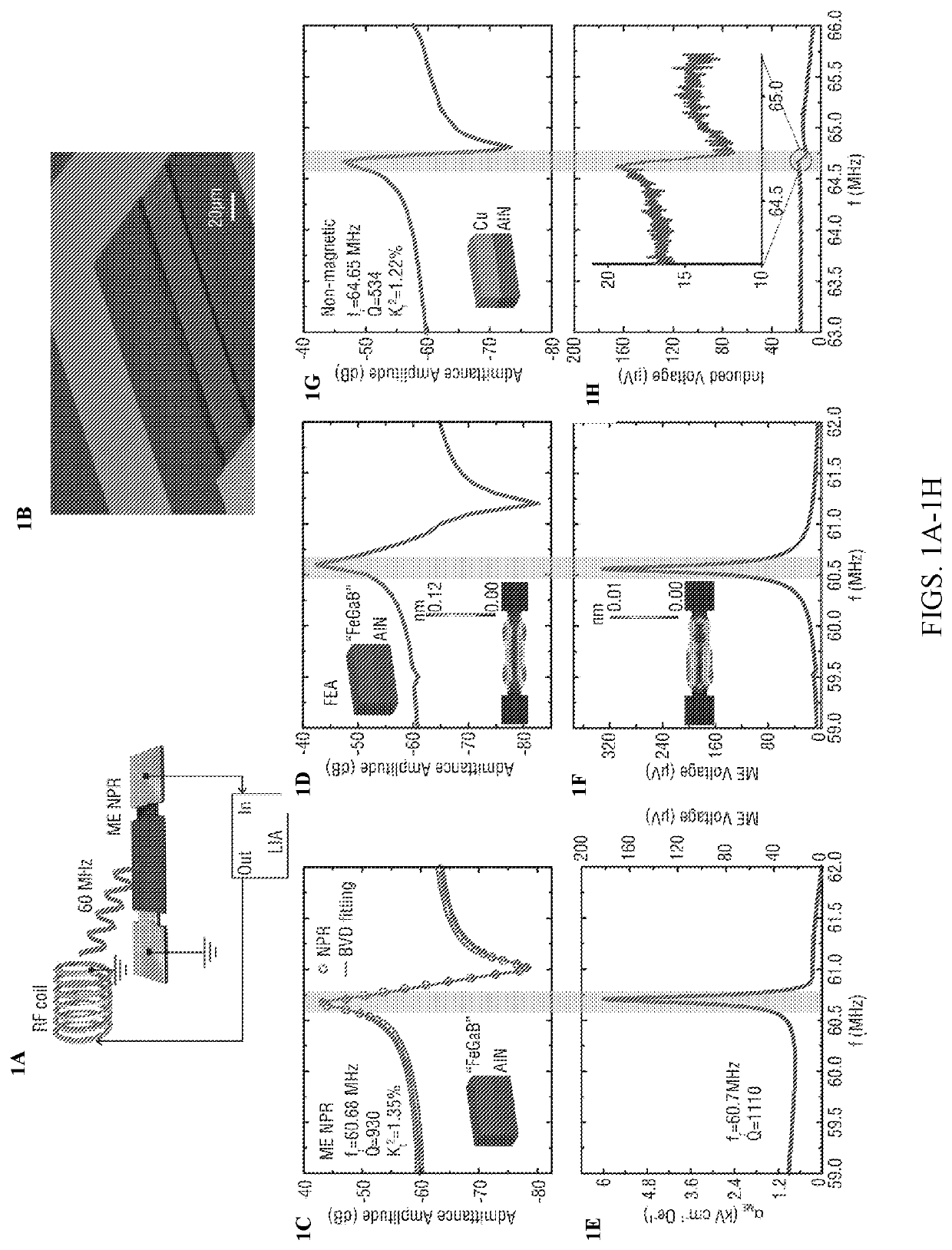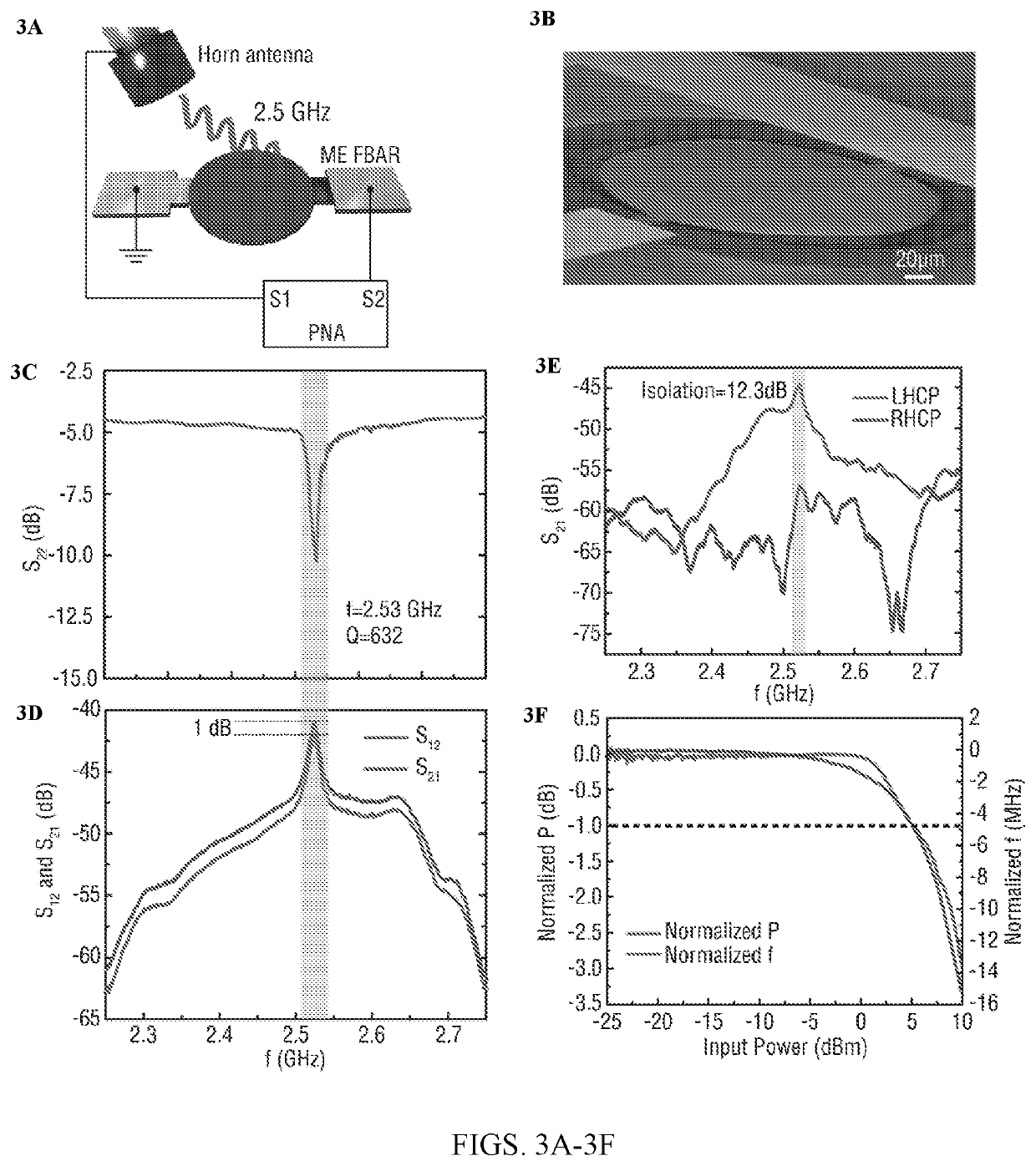Nanoscale Radio Frequency Magnetoelectric Antenna
a radio frequency magnetoelectric and antenna technology, applied in the direction of antennas, device material selection, piezoelectric/electrostrictive device material selection, etc., can solve the problems of severe constraints on radars and other wireless communication systems, and the difficulty of antenna miniaturization
- Summary
- Abstract
- Description
- Claims
- Application Information
AI Technical Summary
Benefits of technology
Problems solved by technology
Method used
Image
Examples
example 2
brication Process.
[0119]The NPR and FBAR devices share the same fabrication process shown in FIGS. 5A-5E. To begin with, a 50 nm thick Platinum (Pt) film (502) was sputter-deposited and patterned by lift-off on high resistivity (>10000 ohm cm) silicon (Si) (501) serving as a substrate, thereby generating the bottom electrode of the device (FIG. 5A). Next, a 500 nm AlN film (503) was sputter-deposited and vias etched (using H3PO4) to access the bottom electrodes (FIG. 5B). The AlN film was further etched by chlorine-based inductively coupled plasma (ICP) (FIG. 5C). Next, a 100 nm thick gold (Au) film (504) was evaporated and patterned by lift-off to form the top ground (FIG. 5D). A 500 nm thick FeGaB / AlOx multilayer film (505) was deposited next by magnetron sputtering and patterned by lift-off (FIG. 5E). Of note, during the magnetic deposition, a 100 Oe in-situ magnetic field bias was applied along the anchor direction (i.e., parallel to the FeGaB / AlOx multilayer film) of the device...
example 3
t Circuit Modeling of NPR Antenna.
[0120]As shown in FIG. 1C, the admittance amplitude of NPR can be fitted with Butterworth-van Dyke (BVD) model to extract the electromechanical parameters such as electromechanical coupling coefficient kt2and quality factor Q. A BVD equivalent circuit consists of electrical components and equivalent mechanical components connected in parallel. The electrical and the mechanical components constitute the electrical and the mechanical branch, respectively. As shown in FIG. 6, the electrical branch includes device capacitance C0, defined by the device geometry, and resistance R0p associated with dielectric loss. The mechanical branch contains motional capacitance Cm, motional inductance Lm, and motional resistance Rm. These components can be expressed as
Rm=1ω0C0kt2Q,Cm=8π2C0kt2,andLm=1ω02Cm.
Series resistance Rs is connected in serial to both branches as electrical loss of the electrodes. Resonance frequency occurs at 2πω0, where the Cm and Lm cancel eac...
example 4
n of RF Coil
[0121]The RF magnetic field used in the operation of the ME NPR devices described herein is generated by a RF coil with an inner diameter of 7.7 mm and 7 turns. The RF coil was soldered on the SMA port and connected to the out-put port of the lock-in amplifier. The magnetic flux density generated by the RF coil was simulated by Finite Element Method (FEM) software, Comsol Multiphysics V5.1. The input for the simulation was RF voltage with a peak-amplitude of 1V. FIG. 7 shows the magnetic flux density as a function of the center axis coordinate (x). The left end of the coil was placed at x=0 mm and the NPR devices under test was placed at x=14 mm. In this configuration, the magnetic flux density applied to the devices under test was 60 nT.
PUM
 Login to View More
Login to View More Abstract
Description
Claims
Application Information
 Login to View More
Login to View More - R&D
- Intellectual Property
- Life Sciences
- Materials
- Tech Scout
- Unparalleled Data Quality
- Higher Quality Content
- 60% Fewer Hallucinations
Browse by: Latest US Patents, China's latest patents, Technical Efficacy Thesaurus, Application Domain, Technology Topic, Popular Technical Reports.
© 2025 PatSnap. All rights reserved.Legal|Privacy policy|Modern Slavery Act Transparency Statement|Sitemap|About US| Contact US: help@patsnap.com



